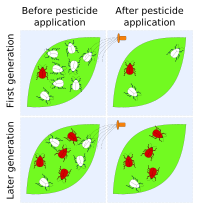
Photo from wikipedia
Tetranychus urticae Koch (T. urticae) is one of the most tremendous herbivores due to its polyphagous characteristics, and is resistant to most acaricides. In this study, enzyme-linked immunosorbent assay (ELISA),… Click to show full abstract
Tetranychus urticae Koch (T. urticae) is one of the most tremendous herbivores due to its polyphagous characteristics, and is resistant to most acaricides. In this study, enzyme-linked immunosorbent assay (ELISA), transcriptome sequencing (RNA-seq) and quantitative real-time PCR (qRT-PCR) were carried out to analyze the mechanisms of T. urticae metabolic resistance to cyflumetofen and bifenthrin on cowpea. The enzyme activity of UDP-glucuronosyltransferases (UGTs) and carboxylesterases (CarEs) in the cyflumetofen-resistant (R_cfm) strain significantly decreased, while that of cytochrome P450 monooxygenases (P450s) significantly increased. Meanwhile, the activities of glutathione-S-transferases (GSTs), CarEs and P450s in the bifenthrin-resistant (R_bft) strain were significantly higher than those in the susceptible strain (Lab_SS). According to the Kyoto Encyclopedia of Genes and Genomes (KEGG) and Gene Ontology (GO) analyses, in the R_cfm mite strain, two carboxyl/cholinesterase (CCE) genes and two P450 genes were upregulated and one gene was downregulated, namely CYP392E7; in the R_bft mite strain, eleven CCE, nine UGT, two P450, four GST and three ABC genes were upregulated, while four CCE and three P450 genes were downregulated. Additionally, 94 differentially expressed genes (DEGs) were common to the two resistant groups. Specifically, TuCCE46 and TuCCE70 were upregulated in both resistant groups. Furthermore, the qRT-PCR validation data were consistent with those from the transcriptome sequencing analysis. Specifically, TuCCE46 (3.37-fold) was significantly upregulated in the R_cfm strain, while in the R_bft strain, TeturUGT22 (5.29-fold), teturUGT58p (1.74-fold), CYP392A11 (2.89-fold) and TuGSTd15 (5.12-fold) were significantly upregulated and TuCCE01 (0.13-fold) and CYP392A2p (0.07-fold) were significantly downregulated. Our study indicates that TuCCE46 might play the most important role in resistance to cyflumetofen, and TuCCE01, teturUGT58p, teturUGT22, CYP392A11, TuGSTd15, TuGSTm09 and TuABCG-13 were prominent in the resistance to bifenthrin. These findings provide further insight into the critical genes involved in the metabolic resistance of T. urticae to cyflumetofen and bifenthrin.
Journal Title: International Journal of Molecular Sciences
Year Published: 2022
Link to full text (if available)
Share on Social Media: Sign Up to like & get
recommendations!